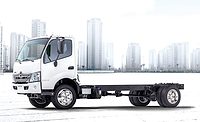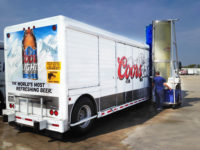Predictive analytics driving delivery forward
Telematics suppliers highlight cost savings, safety from systems

Photo by Quintin Gellar for Pexels/courtesy of Canva
Today’s mission-critical distribution tasks such as fleet tracking, vehicle use and maintenance, scheduling and dispatching, and driver safety and compliance can benefit from telematics. Brand and reputation are riding on customer satisfaction. Meanwhile, operations and safety are dependent on driver retention, behavior and accident prevention that real-time monitoring can provide.
Since electronic logging device (ELD) mandates went into effect in 2019, factors for adoption of telematics include protecting cargo, streamlining delivery strategies, improving customer satisfaction with last-mile efficiency, providing additional driver and customer support with scheduled deliveries and better inventory management. Still, driver retention in a competitive and aging market also is driving telematics adoption in the beverage industry, according to industry experts.
Telematics platforms combining truck and driver safety and vehicle data now video report at 5-G speed anywhere. Specifically, in-vehicle AI technology is learning, adapting — and even training drivers — in real time, experts note.

Both drivers and equipment run at top performance when fleet managers have “valuable information and transparency to better-run their company and team, adhere to safety compliances and remain profitable,” says Oswaldo Flores, product manager at Teletrac Navman, Irvine, Calif.
Safer driving habits reduce vehicle and pedestrian accidents, traffic violations and rising insurance costs, Flores notes. Plus measurable data boosts fleet fuel economy, and extends lifespan, even preventing costly repairs with maintenance alerts, he adds.
On the road, learning hands free
With telematics, information is available in drivers and managers hands and put it into practice immediately, experts note.
“Many beverage distribution fleets are seeing video telematics, and the AI-powered audible alerts they provide to drivers to proactively avoid risks, as a way to more efficiently manage risk for their drivers who might just need a reminder every now and then,” says Zodie Rich, enterprise sales director at Lytx in San Diego, Calif.
Lytx’s video fleet monitoring solution clients include more than a dozen of the country’s top soda bottlers and spirits distributors, Rich notes. “There’s constant pressure to do more with less, and fleets see telematics as one of the ways they can be more efficient,” he says.
Moreover, driver safety and detecting — or preventing — mishaps with telematics today extends beyond in-the-moment correction, as telematics also define training programs complete with scorecards or rewards, Rich notes.
“Machine vision and AI technologies have the potential to look out for patterns that you ‘train’ it to detect. And it can do it in real time, alerting you to events as they happen,” he says. “That can be things like risky patterns of behavior, helping drivers follow safety procedures when doing their jobs (parking, backing up, etc.), or alerting them of potential risks such as driving too fast for adverse road conditions or a low bridge ahead.”
Additionally, for beverage distributors with early morning routes, the tracking of drowsy driving “[with telematics] can help protect drivers and save lives by reducing collisions, distracted driving, and aggressive driving behaviors,” Rich explains. Driver-focused preventative safety measures with telematics not only save lives but lower insurance costs, too, he adds.
Omnitracs One is another AI-driven platform built on years of transportation data and industry expertise launched by Omnitracs, owned by Westlake, Texas-based Solera Holdings Inc.
Its fleet intelligence platform is designed to empower “drivers, teams in the field, and the back office with a single source of truth,” the company says. Additionally, its SmartDrive video safety program for drivers and vehicle video monitoring promotes preventative safety.
Further, Omnitracs’ advanced algorithms allow trucks to be dispatched only where needed, the company notes. This includes maximizing stops each day and for each route, understanding each stop and any changes by the driver, scheduling based on and tracking real-time activities such as arrival time and signatures, or instant messages sent and received, according to Omnitracs company product details.
“Built-in engine diagnostics and the ability to monitor mileage and engine hours in real-time avoids unexpected service issues and maximizes a vehicle’s performance and longevity.”
- Oswaldo Flores, product manager at Teletrac Navman
Vehicle tracking at scale
The cost savings resulting from real-time data feeds include reduced fuel costs, productivity improvement, improved vehicle use and maintenance reporting, according to experts.
In the case of Teletrac Navman Qtanium Connect equipment management platform, it prevents equipment downtime by setting reminders and alerts, and keeps track of maintenance records in one system, according to the company. It takes fleet maintenance to the next level, it says.
“The cloud-based technology mitigates fraudulent insurance claims with at-fault detection and alerts,” Teletrac Navman’s Flores says. “Built-in engine diagnostics and the ability to monitor mileage and engine hours in real-time avoids unexpected service issues and maximizes a vehicle’s performance and longevity.”
The advantage of AI is real-time data trains the diagnostic tools to suggest preventative maintenance and anticipate problems before they occur.
“Some 360-degree HD smart dashcams equipped with an artificial intelligence processor deliver real-time reports and video capture…,” Flores says.
Teletrac’s TN360 product technology is “…making it more accessible and easier to see immediate value and ROI [with TN360],” according to the company. The proactive approach to fleet management through AI technology learns from reactions with faster, accurate insights, it says.
Although the ELD mandate in 2019 forced delivery fleets in the beverage industry to comply for safety, returns on the investment are quickly realized, Flores explains.
“Typically, ROI ranges from 6:1 to 10:1 depending on fleet size and how efficiently a carrier is utilizing its features,” he says. Full use of its telematics system for driving safer, asset tracking and accident alerts, “will pay for itself many times over,” he adds.
Fleet tracking, vehicle use and maintenance, scheduling and dispatching, and driver safety and compliance benefit from telematics. More recently, telematics advances are designed to encourage — and enhance — safe driving experiences and support positive safety culture adoption.
Advances in data availability, reporting, monitoring formats will increase the value of telematics. Mobility and always-on information will continue to increase adoption of telematics for fleet operators always wanting to do more with less.
Looking for a reprint of this article?
From high-res PDFs to custom plaques, order your copy today!





